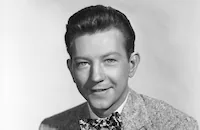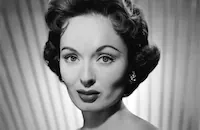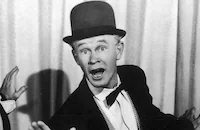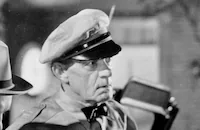The Merry Monahans
Cast & Crew
Charles Lamont
Donald O'connor
Peggy Ryan
Jack Oakie
Ann Blyth
Rosemary Decamp
Film Details
Technical Specs

Synopsis
In 1899, at the Boston Empire Theatre, vaudevillian Pete Monahan proposes to his partner, Lillian Rice and is accepted in the midst of their performance. Backstage, however, show girl Rose announces that she is already engaged to Pete, asserting that he had drunkenly proposed to her the night before. Learning of Rose's claim, Lillian leaves Pete, and he, in turn, marries Rose. Pete and Rose then form their own act, and with the addition of their son Jimmy and daughter Patsy, they become the Four Monahans. Rose later deserts her family and leaves Pete a note admitting that he never proposed to her, that he had only told her how much he loved Lillian. At the start of World War I, the Three Monahans are playing the Colonial Theater in Schenectady, New York when they are offered the headlining position at the Empire Theatre. The sentimental Pete refuses to return to Boston, so in retaliation, Henderson, the district booker, fires them from the Colonial as well. The Monahans fortunes improve, however, when a theatrical agent offers to handle their act and books them on the prestigious Keith theater circuit. On a train to Philadelphia, the now-teenaged Jimmy meets Sheila DeRoyce, Lillian's daughter. Thinking that Jimmy is merely a hobo, Sheila tells him that she and her mother are performing on the Keith circuit with famed actor Arnold Pembroke. When they meet again backstage, she learns who Jimmy really is. Pete also gets re-acquainted with the widowed Lillian, and Pembroke jealously threatens to replace the DeRoyces if Sheila continues to spend her time with Jimmy rather than rehearsing. In actuality, Pembroke is aware that the talented Sheila is the only reason that he remains on the Keith circuit. Upon arriving in San Francisco, Pete tells his children that he plans to propose to Lillian that night, only to learn later that she has just become engaged to Pembroke. The heartbroken Pete then begins drinking heavily, unaware that Lillian is marrying Pembroke only to ensure Sheila's future. After Jimmy and Patsy are forced to perform without their drunken father, Weldon Laydon, the producer of the Manhattan Follies, offers to book the brother-and-sister act, but they, unaware of who he is, refuse his offer. Later, Sheila runs away from Pembroke and her mother, and she and Jimmy decide to elope. They are stopped, however, by Lillian and Pembroke, after which Pembroke admits that his ego can no longer accept Sheila as the star of their act, and leaves. Meanwhile, an upset Pete throws a brick through a liquor store window and is sentenced to thirty days in jail. With their father in jail, Jimmy and Patsy then join the Manhattan Follies. They quit the show, however, after Weldon tells them that their father will not be allowed to join the production. Pete is released from jail just as Prohibition is passed, but having read his children's rave review in Variety , he refuses to return to the act and goes to work on the Patriotic Charities Benefit Show. Jimmy and Patsy join their father on stage, however, and when Weldon sees their performance, he agrees to book the trio. Pete and Lillian are then reunited, as are Jimmy and Sheila, and the Monahans are now a quintet.

Director
Charles Lamont
Cast

Donald O'connor

Peggy Ryan

Jack Oakie

Ann Blyth

Rosemary Decamp

John Miljan
Gavin Muir

Isabel Jewell

Ian Wolfe
Robert Homans

Marion Martin

Lloyd Ingraham

Billy Benedict
Duke Johnson
Murray Parker
Ronnie Rondell
Bobby Barber
Al Thompson
Herbert Heywood
Jimmy Bates
Arthur Loft
Lew Wood
Ray Turner
Cy Ring
Jack Gardner
Harry Tyler
Harry Harvey
Eddie Bruce
Herbert Weber
Frank Penny
Jack Rice
Andrew Tombes
Edgar Dearing
Syd Saylor
Ernie Adams
Kernan Cripps
Matt Mchugh
Patsy Moran
Robert Emmett Keane
Doodles Weaver
Bill Cartledge
Al Bridge
Pearl Early

Lew Kelly
Robert Barron

Emmett Vogan
Polly Bailey
Earle Hodgins
Patsy O'byrne
Phil Dunham
Ella Ethridge
Nolan Leary
Bobbie Hale
Art Miles
Pat Gleason
Crew
Irving Bibo
James Bland
Shelton Brooks
Bernard B. Brown
Vincent P. Bryan
Charles Carroll
Earl Carroll
Harry Carroll
Grant Clarke
Louis Da Pron
Gus Edwards
Leo Edwards
Michael Fessier
Michael Fessier
Stephen Foster
A. F. Frankenstein
John P. Fulton
Russell A. Gausman
Don George
John B. Goodman
Archie Gottler
Jack Gross
Art Hickman
Howard Johnson
Sam M. Lewis
Frederick Knight Logan
Jack Mahoney
Charles Maynard
Joseph Mccarthy
James V. Monaco
Martin Obzina
Ernest Pagano
Ernest Pagano
Carlos Romero
Hans J. Salter
Henry J. Sayers
Jean Schwartz
J. R. Shannon
F. B. Silverwood
Leigh Smith
Charles Van Enger
Percy Wenrich
Vera West
Harry Williams
Mack Wright
Joe Young

Film Details
Technical Specs

Award Nominations
Best Score
Articles
Peggy Ryan (1924-2004)
Born Margaret O'Rene Ryan on August 28, 1924, in Long Beach, California, Ryan began dancing professionally as a toddler in her parents' vaudeville act, the Dancing Ryans, and was discovered by George Murphy when she was 12. Murphy arranged for young Peggy to dance with him in the Universal musical Top of the Town (1937). She would go on to make a few more film appearances over the next few years - the most striking of which as a starving, homeless girl in John Ford's The Grapes of Wrath (1940) - yet for the most part, she was hardly noticeable apart from a few dance numbers.
Her luck changed when Universal cast her opposite another teenage hoofer, Donald O'Connor in What's Cookin'? (1942). From then on, they teamed in a series of innocuous musicals that were low on production values, but high on youthful pluck. Just check out some of their titles: Private Buckaroo, Give Out, Sisters!, Get Hep to Love (all 1942); Top Man, Mr. Big (both 1943); Chip Off the Old Block, This Is the Life, and Bowery to Broadway (all 1944). They may have not been high art, but jitterbuggin' kids loved it, and given the low investment Universal put into these pictures, they turned quite the profit.
Her career slowed down after the war. In 1945, she married songwriter James Cross, and didn't return to films until 1949, when she made two minor musicals that year: Shamrock Hill, There's a Girl in My Heart. She divorced Cross in 1952 and met her second husband, dancer Ray McDonald, in her final film appearance, a forgettable musical with Mickey Rooney, All Ashore (1953). Tragically, McDonald died in 1957 after a food choking incident, and the following year, Ryan moved to Honolulu after marrying her third husband, Honolulu Advertiser columnist Eddie Sherman. She kept herself busy teaching dance classes at the University of Hawaii, but in 1969, she found herself back in front of the camera as Jenny Sherman, secretary to Detective Steve McGarrett (Jack Lord) on the long-running show Hawaii Five-O,. She played the role for seven years, remaining until 1976.
Eventually, Ryan relocated with her husband to Las Vegas, where for the last few years, she was teaching tap dancing to a whole new generation of hoofers. She is survived by her son, Shawn; daughter Kerry; and five grandchildren.
by Michael T. Toole

Peggy Ryan (1924-2004)
Quotes
Trivia
This film has 20 song/dance numbers of at least two minutes each. This leaves 31 minutes for plot developments, which is enough.
Notes
According to Hollywood Reporter, this film had the largest budget to date of any picture starring actor Donald O'Connor. In September 1943, Hollywood Reporter announced Frank Ryan as the director of the film, with principal photography scheduled to begin on October 11, 1943. Ryan, however, was replaced by Charles Lamont, and shooting did not commence until December 6, 1943. During one production number in the film, actress Peggy Ryan does an impersonation of singer Sophie Tucker while singing Tucker's trademark song "Some of These Days." Donald O'Connor, in turn, does an impersonation of Al Jolson singing "Rockabye Your Baby with a Dixie Melody." According to Universal press materials, O'Connor was originally scheduled to do his Jolson impersonation in blackface to the melody "Mammy," with words and music by Sam M. Lewis, Walter Young and Walter Donaldson. A Hollywood Reporter news item stated that actor Sidney Blackmer was to play a featured role in this film, but he did not appear in the film. Hollywood Reporter production charts included Billy Curtis in the cast, but his participation in the released film has not been confirmed. According to Hollywood Reporter, the radio program Double or Nothing dedicated its September 15, 1944 broadcast to this film. Hans J. Salter was nominated for an Academy Award for his music score, but lost to Carmen Dragon and Morris Stoloff's Cover Girl score (see entry above).














